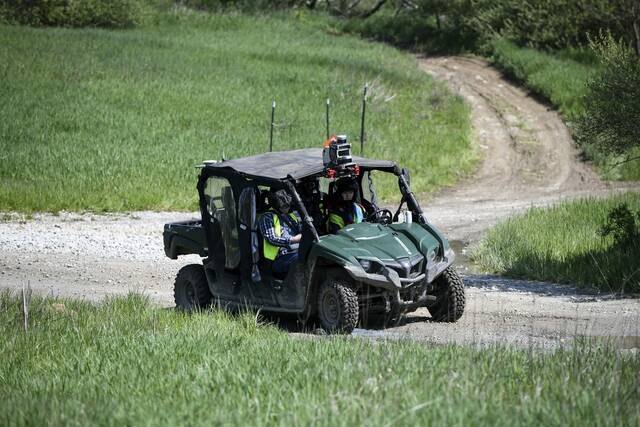https://triblive.com/business/technology/cmus-tartan-driver-takes-autonomous-driving-off-pittsburghs-beaten-path/
CMU's Tartan Driver takes autonomous driving off Pittsburgh's beaten path

All-terrain vehicles one day may be able to venture where no human dares to go using their own artificial intelligence.
It could be to fight a raging wildfire or to rescue someone trapped in a remote location. And they may do so using a successor to Carnegie Mellon University’s TartanDriver.
The TartanDriver is the self-driving ATV that CMU’s researchers have been working on for more than three years. In early May, researchers demonstrated the Tartan’s chops publicly at Renegade Ridge, an ATV park west of Steubenville, Ohio.
At first glance, this modified Yamaha Viking doesn’t look different than the stock model, except for the small stack of sensors mounted on its roof. There are also three white-tipped antennae that resemble magic wands mounted on the front and rear of the driver’s side.
Yifei Liu, a graduate student at the Air Lab that’s part of the CMU Robotics Institute, was in the driver’s seat and equipped with a video game controller. This wouldn’t be an ordinary joy ride.
The Viking is an $18,000 ATV used to navigate terrain that would pose a challenge to a larger pickup or Jeep. It can accelerate to about 50 mph and is slightly larger than a golf cart.
To drive the Tartan, Liu uses the video game controller. It’s like playing Nintendo’s Mario Cart in real life, she said.
Renegade Ridge offers terrain of hills, rocks and fields that the CMU team has been using to calibrate the Tartan.
“It is a very big challenge to figure out, ‘Where can I drive safely?’ ” Sebastian Scherer, a CMU robotics professor, said of the approach toward programming the Tartan. “Here, we are trying to figure out, ‘Can I go through this grass?’ ‘Is this gravel safe?’ ‘Am I going to get stuck in the mud?’ ”
The yearslong process started by gathering datasets while the vehicle was driven by a human. That data was used to help the computer determine what it is encountering — for instance, traveling through mud or gravel or grass or what a tree looks like — when it is driving autonomously.
On this day, with Liu in the driver’s seat, the Tartan approached a course set by the research team. But it wasn’t governed by roads or even a trail. Instead, transponders were placed at various points on the course, and during each run it figured out its own path among those points.
Traveling in the Tartan as it navigated the area was like being on a roller coaster that wasn’t confined to tracks and that wasn’t driven by a person.
The Tartan handled the course without a hiccup, as Liu and her colleagues monitored things using laptops that tapped into the data the Tartan’s sensors were gathering in real time. They could take over the controls if needed, but that wasn’t required.
Growing steadily
Led by CMU, the autonomous vehicle industry has grown in Western Pennsylvania.
Pittsburgh-based Aurora Innovation, whose founder has ties to Carnegie Mellon, launched its autonomous trucking program in May in Texas and by the end of the year plans for it to operate in West Texas and Arizona. Aurora’s leaders didn’t respond to requests for an interview.
A test track in Westmoreland County is also set to be built by PennDOT and the Pennsylvania Turnpike Commission. It will be used by emergency responders, transportation organizations and researchers.
Related:• Self-driving vehicle testing in Pittsburgh area shifting gears to focus on trucking industry • $20 million self-driving vehicle testing, training facility to be built in East Huntingdon
Autonomous vehicle technology has advanced as artificial intelligence creeps into all sectors of life.
The technology of navigating a vehicle on a road is something that’s pretty much been perfected, CMU robotics professor Jeff Schneider told TribLive.
The challenge now is in the fine details that also are the most vital: how to respond to what researchers call the “long tail of rare events,” Schneider said.
In short, this is what an autonomously driven vehicle does when a child runs into its path or a basketball bounces before it or something else happens which requires that split-second decision that also perplexes human drivers.
“The big challenge is how you model those rare actions in your simulations,” Schneider said.
To do this, researchers use generative AI, the same technology that is used by Chat GPT, Google Gemini, Grok and others. It also is used to develop those scenarios and how the autonomous driver responds to them, Schneider said.
Pittsburgh remains a draw for companies and people who want to use AI, robotics and other technology, he said.
“We’re still a place that outputs the best and the most talent,” he said.
Copyright ©2025— Trib Total Media, LLC (TribLIVE.com)
